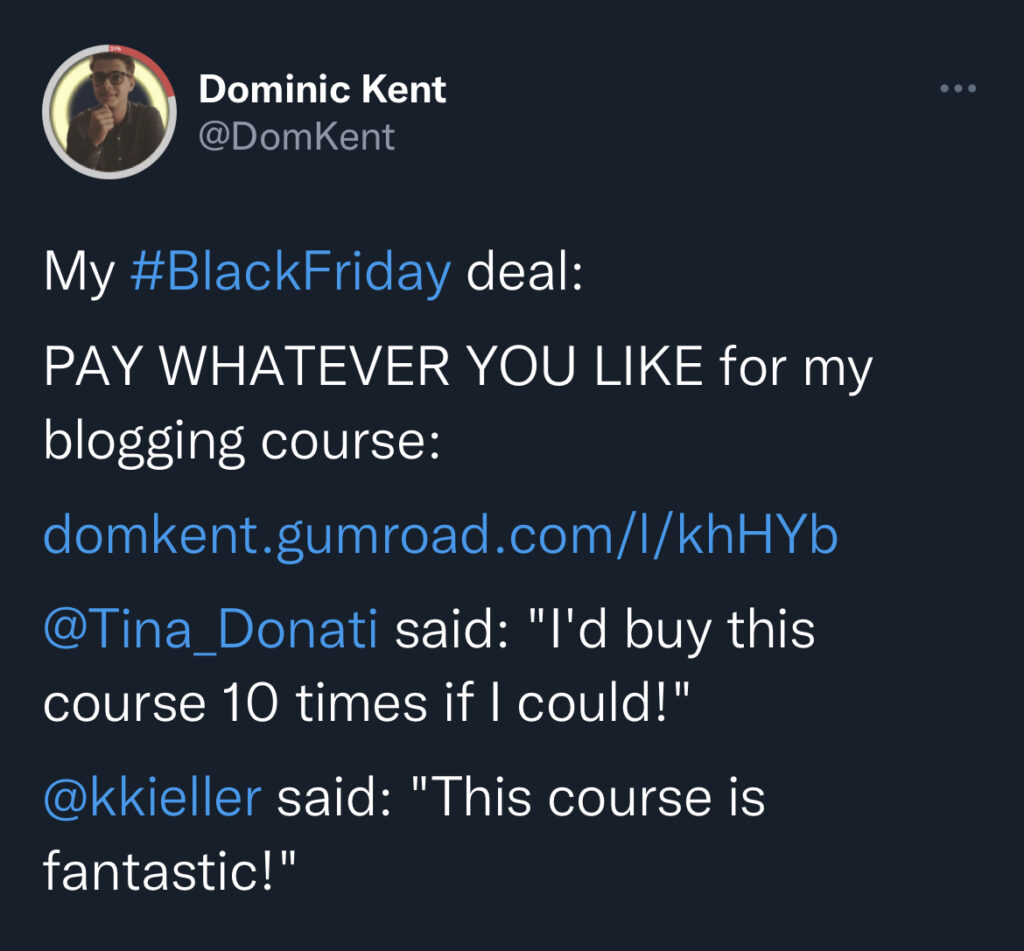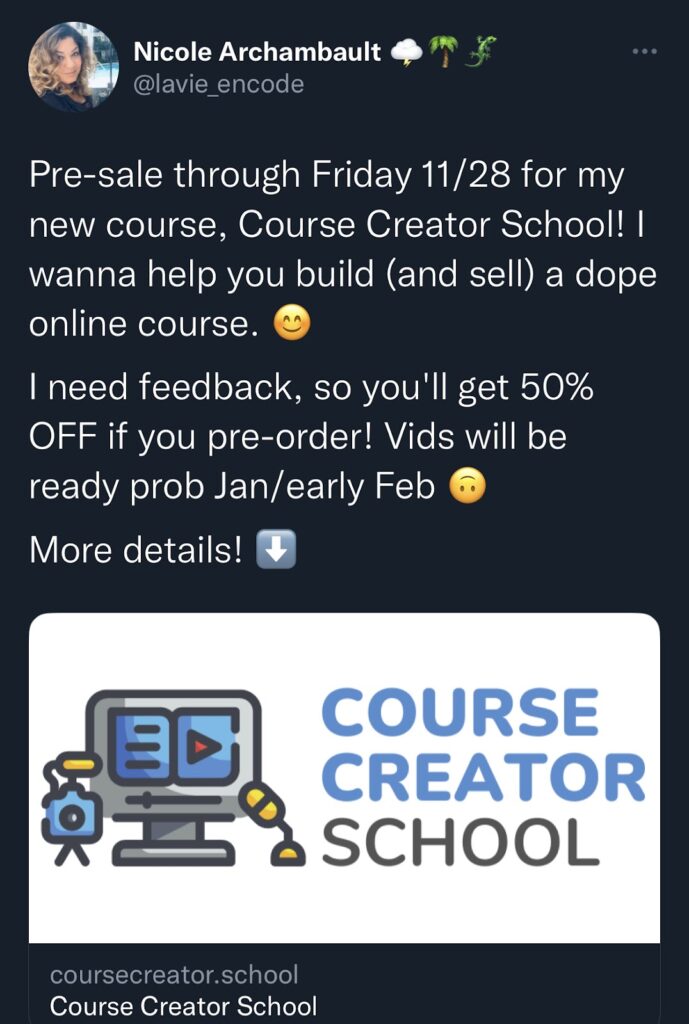“Build it and they will come,”… said no video course creator ever 🫠. Just because you’ve done the hard work of putting a course together doesn’t mean people would flood you with purchases.
If you want people to buy your course, you need to put on your “salesperson” hat and get familiar with pricing strategies and marketing. In this article, we will take you through all the hooks and tricks of selling video courses — so you can earn big bucks for your hard work! We’ll cover:
Skip ahead:
Tips for creating a successful video course
To make big bucks from selling your course, you need to lay the groundwork early. In practice, selling a video course starts from the moment you decide to create one.
Make sure there’s a demand for your course
A video course will simply be a waste of resources if nobody needs it or is willing to pay for it. It’s like cooking a meal that no one wants to eat.
Ryan Turner, founder of Ecommerce Intelligence, says, “my best advice is you really want to be sure that there is a need and a demand for your course and that people are gonna pay for it. It’s very easy to be passionate about one very specific thing that you really like and create a course. Then you might realize that maybe people just aren’t interested in paying for this information.”
There are two ways to create demand for your course.
Build an audience
Start building an audience early so you have a list of people to market to when your course goes live. And there are several ways to do this:
- Put out content related to your course on social media platforms
- Host events
- Go on industry podcasts
- Organize one-on-one mentorships and consultations
- Start a newsletter
Say you want to launch a video course about health and fitness; start by sharing bite-sized videos about these topics on YouTube, for instance.
Lily Ugbaja, content strategist and founder of findingbalance.mom, says sharing content for free can be a game-changer for first-time creators. “For me, doing more free stuff — offering free consulting, offering free coaching, putting out videos on Youtube — all these things really helped build my audience. Just make videos because your first video is going to suck. And doing it repeatedly, when there’s no pressure of getting paid yet, helps you be yourself and teach naturally.”
By consistently putting out content, people start to know, like, and trust your expertise. In Lily’s words, “you learn to create videos that actually work and what people find valuable. You learn to sell because even free things have to be sold. So it sets you up for success. You gain an audience so that when you are launching, you already have an audience to launch to. You’re not singing to crickets.”
Anna Davidson, veteran ecommerce coach, shares a similar opinion. “Build a social community whether it be on titok, Instagram, facebook or telegram. Give value and free content so that your audience knows you’re an expert in your field. And buying your course will be a no-brainer for them.”
Research other video course creators in your niche
If other creators have launched and sold video courses in your niche, it means there’s a market for your course. You can search marketplaces like Udemy and Coursera to know if there are already courses covering the subject matter you want to target. Focus on information like:
- How much they are selling these courses for
- The number of sales they’ve made since the course launched
- What the reviews are like
Consider enrolling for one of the existing courses to get an idea of the type of content they deliver and what the market generally expects from video courses in your niche.
Invest in the right video creation equipment
Crappy equipment can ruin your video and the overall learner experience. Your course might have great content, but if, for instance, the lighting is poor, people will abandon it — they’re trying to learn, not watch a Batman movie.
The right equipment doesn’t necessarily mean the most expensive one. You can shoot engaging videos on a budget. Say you have $1,000 to invest in video creation equipment:
- Get a lapel or lavalier mic for $40
- Get a ring light kit for $50
- Get a camera for $700
- Get a video backdrop for $15
Read more: Best Equipment & Software for Creating Online Courses
Cut the fluff
Most first-time video course creators overload their courses with information, which turns off learners.
“I took months making the initial version of my course because I wanted it to be the best one out there,” says Ryan. “And I obviously think it was the best one out there. Still, I had too much in it that was not absolutely necessary. I think it would’ve put some people off like: Oh man, I got to watch this module, and it has like six videos, and they’re all like an hour long or something.”
Your course should focus on one thing. Ask yourself, what is the one thing I want people to get from this course and only include content that’s relevant to this outcome. Any other thing is fluff. As you collect feedback from learners, add modules and tweak the course content to better meet learners’ needs.
“Most people overcomplicate things and think they need to make a video course that covers every little detail. In reality, most successful courses are small and focus on improving one key aspect that moves the needle. Then when you have time to cover another key aspect, you can sell it again,” Bart van der Meer, founder of greenmatch.co.uk adds.
Optimize your video course for bite-sized learning
Literally, no one wants to watch a 5-hour long video course at a stretch — that’s something Ryan Turner knows all too well.
“The first version of my course was too long. Some of the videos in the course were over an hour long, and, you know, it was just too much information. I think, for a lot of people, it’s hard to watch someone on a screen share for an hour. It can be boring. You can’t sustain engagement for that long.”
Break your course content into 10–15 minutes long modules — don’t have one module that’s an hour long. Add quizzes and other interactive exercises at the end of each module to slow down the learning pace.
Another advantage of bite-sized learning is flexibility. Many times, people want to learn one specific thing from your course. “With bite-sized videos, people can just go in and see, okay, this is the little bit of information I want. I can watch this rather than go through some huge module. You might be surprised at how many people buy your course looking for just one piece of knowledge, and they’re fine with that. Don’t assume that everybody’s going to watch everything,” Ryan adds.
Make money from your video content (without the cost or loss of control)
Sign up for Thinkific’s free plan to share your knowledge and generate revenue from your video content — all from a single platform that you control.
Selling your video course
You have done the groundwork and created an engaging and relevant video. Now, it’s time to sell it!
Set your price
Pricing is crucial. If you charge too little, you won’t make a profit, and your credibility could suffer if people think the product isn’t worth the investment. On the other hand, charging too much may turn away potential customers and reduce your chances of making a sale.
Unfortunately, course pricing isn’t a linear process. But there are key things to consider as you brainstorm.
Your cost of production
At a basic level, your price should cover the cost of producing the video course, so you don’t make a loss. Stella Chenjie Guan, founder, and CEO of Path Unbound, shares her four-step for this:
- First, calculate your overhead. How many expenses do you have for running your school? That includes the time you spend creating the course yourself or with a team. Use a rate that you would normally charge for a client.
- Then, figure out your net profit goals. How much money do you want to make from this?
- Add your expenses to your net profit goals.
- Think about how many students you can attract reasonably. Use that to divide then you will have your course pricing. For example, if you spent $2000 creating the course; want to make $200,000 with your course a year, think you can attract 300 students to sign up. Then your course should be ($2000+$200,000)/300=$673 per student.
Read more: How to Price Your Online Course
The degree of authority you’ve built in your niche
This is where building an audience comes in handy. If you’ve already gained credibility with potential buyers, you can set a high price point for your course. Some creators sell out high-ticket courses within an hour because they’ve built a solid reputation over time, with results to show for it.
“The trust factor is key,” says Lily. “Like how well-known are you? How much credibility you have in the industry determines how much you can charge, to a large extent.”
The average market price
To make sure you’re not pricing yourself out of the market:
- Check educational platforms like Udemy and Coursera to know the average price of video courses in your niche
- Conduct a survey to know the lowest and highest price buyers are willing to pay for video courses in your niche. “Sometimes courses that are inexpensive are viewed as less valuable by certain audiences. Know how your audience perceives value and cost’” says Alaina Szlachta, founder and Lead Learning Architect at By Design Development Solutions.
Say the courses in your niche cost between $100 and $500; it would not make much sense to charge $2,000 for your course unless you can provide unique value your audience can’t access elsewhere — which brings us to the next point.
The value of your course
If your course provides some exclusive benefits to learners — like access to a private community or a one-on-one consultation — then you can charge above the average market price for it.
“When I launched my course, it was $997. And the reason for that was there was obviously a huge amount of information in the course, but I wanted to have really good support after. So I had a private customer group on Facebook where I would interact with people in the course and give them support after they’d purchased. I allowed people to also book two one-on-one sessions with me as part of the package. I wanted to give people the best possible chance of getting results and to have access to me, so I could help them personally. And obviously, if I’m going to do that, I can’t do that for 500 people. Yeah. So I was like, okay, higher price, a smaller number of people, but give them an amazing experience,” Ryan explains.
If you do end up fixing a higher price point for your course, you can still cater to the market by:
- Allowing people to pay in installments instead of supporting only one-time payments
- Creating a lower pricing tier with limited features
Upload your course to a hosting platform
The hosting platform is where your video course lives. You have a ton of options — from self-hosting sites like Veed and Wistia to course platforms like Thinkific and Teachable.
The exact process of uploading your course depends on the platform. If you’re using an educational platform like Thinkific, add the videos directly to your course video library to make it available for your students.
Choosing a hosting platform is one of the most important decisions you will make as you prepare to sell your course. Different things matter to different creators, but you should pay attention to three main things:
Security
The hosting platform should have security features like access control and data encryption to protect your intellectual property and reduce the risk of your content getting hacked and stolen.
User Experience
The hosting platform should be easy-to-use. Anyone with a basic knowledge of the internet should be able to navigate the platform.
“The platform should support a simple user experience,” says Lily. “Features like single sign-on where someone has just one account with that education platform, and they’re able to use it to sign into all the courses that they’ve bought even though it’s not in the marketplace. Also, the interface needs to be so friendly that when someone finishes watching one of the videos, they should be able to click into the next one without any friction — just a click of the button.”
Convenience
The best video hosting platforms are the ones that act as one-stop shops for everything you need to launch your course — from creating the videos to building landing pages and sending email drips to your target audience.
Ryan Turner says, “For me, the most important thing was an all-in-one platform where I could do everything at once. Obviously, having a nice area that’s user-friendly for people to actually go through the course is important, but I wanted a platform where I could do all of the email marketing for the course, you know, build landing pages, sign up pages so that I really only needed one piece of software to do all of the hosting and the marketing and everything in the course. Basically, I built a mini-site all on one platform for my course. That just saved me so much time instead of trying to tie all these different technologies together and use different tools for different things. That was the main thing for me.”
Create a landing page
Landing pages are where potential buyers go to learn more about your course offering, and directly impact whether or not a person buys the course. High converting landing pages:
- Have a clear and specific call to action like “sign up”, “register”, “take me to the course”
- Have social proof like testimonials from beta-testers
- State how the course solves a specific problem for the potential buyer
If you’re tech-savvy, you can code a landing page from scratch using website builders like Wix or WordPress. However, first time creators (and creators who want to save time) are best off using an educational platform to create and publish course landing pages from one place without writing a single line of code. Thinkific, for example, has customizable elements — like countdown timers, call-to-action buttons, headers and images — that you can tweak easily to create a professional landing page in minutes.
Related: How to create a landing page on Thinkific
Market your course
Having a course is just half of the puzzle. The other half is getting in sales. Make sure you spend just as much time marketing the course as you did creating it.
You can use numerous marketing tactics and strategies to generate interest and attract customers, and each one will likely yield a different result.
Read: How to market your online course
Promote the course within your network
Put the word out on owned channels — like your email list and private community — and third-party channels like social media platforms and industry communities to let people know your course is live.
The people in your network already trust you to an extent, so a number of them might be early adopters and sign up for your course. You can even throw in a discount to encourage them to buy.

Run paid ads
Paid ads can help you reach people beyond your network and drive more course purchases. For example, Instagram ads can reach up to 2 billion people!
Run ads on the platforms that your target audience engages with the most. For example, LinkedIn is the best ad platform to invest in if you’re targeting C-level executives because that’s where most C-level folks hang out. Ad platforms allow you to target specific audience profiles with your ads to increase their chances of converting.
Related: How to use Facebook ads to promote your online course
Presell the course
Preselling your course is a great way to generate early sales and build a customer base for future marketing efforts. It can also provide valuable feedback that you can use to refine your course content before its official launch.
And it’s pretty easy to do — put word out to your audience to let them know your course is on pre-sale for a lower price for a limited period. You can create a sales page for your soon-to-be-released course with Thinkific and seamlessly collect payments and buyer information.

Source: Twitter
Plan for evergreen launches
Evergreen launches are marketing’s best-kept secret. It means launching your course on a rolling basis, allowing new customers to sign up and join the course at any time. It’s a smart way to keep earning revenue from your courses round the clock.
To do this, set up an automated email marketing sequence that repeatedly markets to new folks as they enter your sales funnel. For example, whenever someone signs up for a freebie on your website, they automatically receive a welcome email sequence for a limited time leading them to sign up for your course.
“Most people don’t know that you can have an evergreen launch, where your email marketing funnel is set up in such a way that you are launching to each person at their own timeline, instead of doing cost launches like every few months,” Lily explains.
Track your sales results
Selling your course isn’t a one-time business. You need to continuously tweak your overall sales strategy based on the results you’ve achieved.
Dig into the data and analyze the results of your promotional efforts. Are you reaching the right people? Are you using the right marketing materials? Answering these questions will help determine where to focus your efforts going forward.
Happy Selling!
Make money from your video content (without the cost or loss of control)
Sign up for Thinkific’s free plan to share your knowledge and generate revenue from your video content — all from a single platform that you control.








